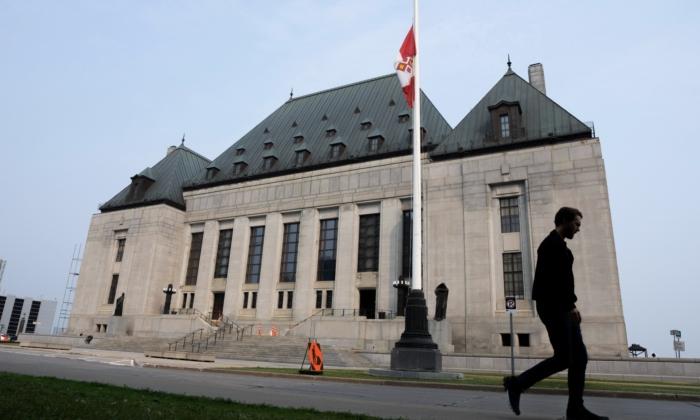Prime Minister Justin Trudeau is set to appoint a new judge to the Supreme Court of Canada, an institution that has considerable power over policy compared to elected officials—and for much longer, say policy experts.
“The Supreme Court has a veto power over provincial governments, and it has the same veto power over the federal government,” said Ted Morton, professor emeritus of political science at the University of Calgary and a former Alberta Progressive Conservative cabinet minister, in an interview with The Epoch Times.
Supreme Court judges have increasingly become “activists” ruling not on the legal merit of cases but on what they think is best for Canada, Morton said.
“My job is simply to listen to what the parties have to say, and to do my best to understand the position, the ramifications of deciding one way or the other, to think about what’s best for Canadian society on this particular problem,” she said.
Morton and others are worried that what they characterize as the court’s activism will increasingly favour the Liberal Party’s view of what is best for Canadian society, due to the selection of who gets to sit on the bench.
The latest vacancy in the court resulted from the resignation of Justice Russell Brown of Alberta, appointed by former prime minister Stephen Harper. Brown was one of the few more conservative-minded judges, and Trudeau is unlikely to appoint any such judge to fill his place, Morton said.
“It’s likely to be somebody who has close ties and has the same ideology or same philosophies as the Trudeau government,” he said.

Into the 2040s
Trudeau has already appointed five of the nine judges—this will be his sixth—an unusually high number for a single prime minister. And these judges may carry his policy priorities and values into the 2040s, said Thomas Klassen, a York University public policy professor, in an article for The Conversation published June 21.Supreme Court judges serve until the age of 75, which means Trudeau’s most recent appointments, Justice Michelle O'Bonsawin and Justice Mahmud Jamal, could serve until 2049 and 2042 respectively.
“By then, Trudeau will be long gone from the political arena, but his priorities and values will continue to shape the nation,” Klassen said. “In fact, the Supreme Court already bears Trudeau’s stamp given O'Bonsawin is the first indigenous Supreme Court justice and Jamal is the first racialized Canadian to be named to the court.”
Climate Change Policies
The judges upheld the Liberal government’s carbon pricing policy 6–3 on the reasoning that climate change is a threat of “national concern,” thus giving the federal government jurisdiction and overriding provincial objections, including Alberta’s.And Morton predicts the same results for an upcoming decision on Bill C-69, often called the “No More Pipelines” bill because of the regulatory burden critics say it puts on major infrastructure projects. Alberta is also a primary force in challenging that law, given its implications for the oil industry.
Elected Officials, Appointed Judges
Morton said it is concerning that Supreme Court judges, rather than elected officials, are the ones with the power to make such impactful decisions.“Every province is unique, and federalism allows each province to be governed primarily by people that they elect. Those are people that come from their neighbourhoods, understand their issues, and every four years are accountable back to the people that have to live with those policies,” he said.
“There’s no accountability for the Supreme Court. These are distant, faraway judges who have no feel, no sense of what local or regional communities want or think are important.”
Canadian scholar and author William Gairdner looks to British history, the roots of Canada’s governing system, in likewise arguing that the Supreme Court should not effectively have the power of lawmakers.
Gairdner told The Epoch Times that in England, in the 16th and 17th century, Parliament sometimes served as a court. For instance, it tried King Charles I and ordered him beheaded. But after the Restoration period, a clear separation emerged with the idea that Parliament should make the laws and courts should rule on them.
“Parliament should no more try a murderer than a court should make a law,” Gairdner said.
How the Charter Changed the Court
Gairdner is among many who have written about the changes the charter created in the role of Canada’s Supreme Court.Many have said the charter elevated the role of the court by allowing judges to make sweeping legal changes through their interpretation of the charter’s meaning. It gave the court more power to dismiss the decisions of Parliament and legislatures if those decisions didn’t align with their charter interpretations.
The so-called “living tree” view of the law took root, which holds that the law grows and changes like a tree, Gairdner explains.
“The idea is that it should change, and it should evolve—they use the word ‘evolve’ instead of the word I prefer, which is ’mutate,'” he said. “Mutations are not always good.”
The opposite of the “living tree” view is not about everything staying absolutely the same, but about change being initiated by elected officials. Elected officials make laws and judges do their best to uphold those laws according to the lawmakers’ intent.
Lawyer Gwendolyn Landolt, who has been a close observer of Canadian politics for decades, recalls her thoughts in 1982 when the charter came into force.
Who’s Doing the Appointing
Stephen Harper appointed three judges when he was prime minister, and they are clearly not all conservative, Landolt said.Landolt said she doesn’t have faith in Trudeau’s ability to pick a judge on legal merit or to consider the need for judges with varying perspectives.
While the prime minister is expected to consult with others, the decision is ultimately his.





